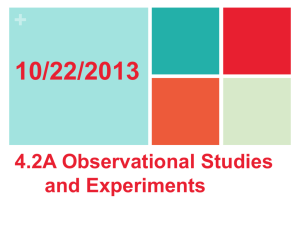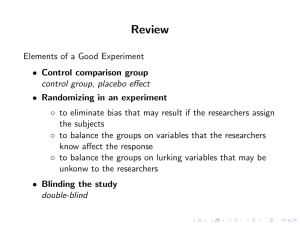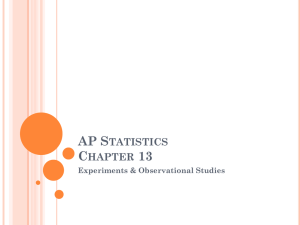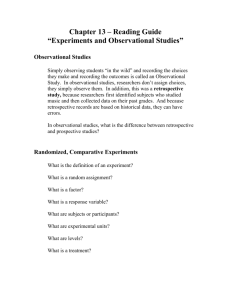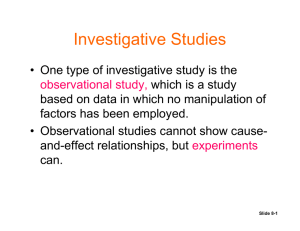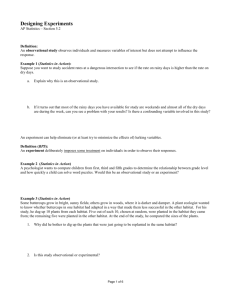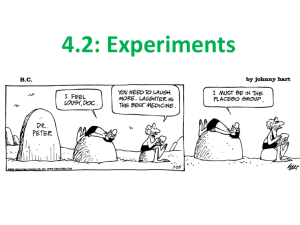Section 4.2 First Day Experimental Design
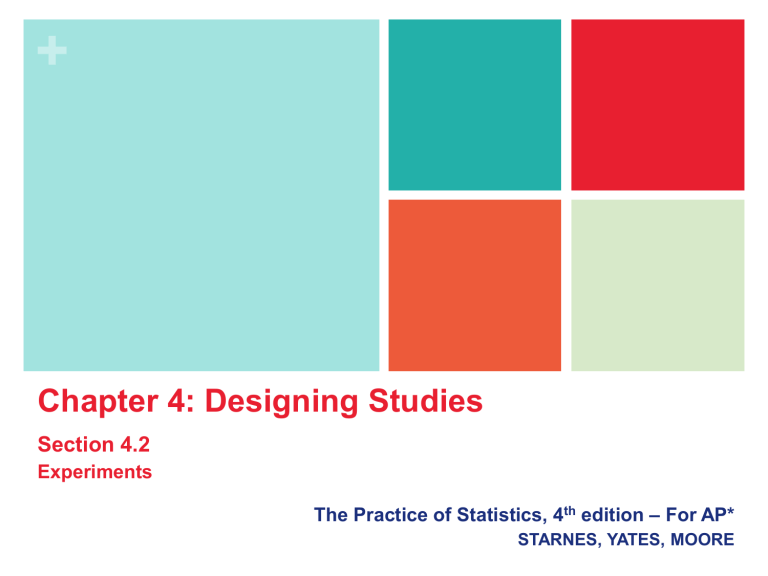
+
Chapter 4: Designing Studies
Section 4.2
Experiments
The Practice of Statistics, 4 th edition – For AP*
STARNES, YATES, MOORE
Observational Study versus Experiment
In contrast to observational studies, experiments don’t just observe individuals or ask them questions. They actively impose some treatment in order to measure the response.
Definition:
An observational study observes individuals and measures variables of interest but does not impose treatment on the individuals.
An experiment deliberately imposes some treatment on individuals to measure their responses.
When our goal is to understand cause and effect , experiments are the only source of fully convincing data.
The distinction between observational study and experiment is one of the most important in statistics.
Observational Study versus Experiment
Observational studies of the effect of one variable on another often fail because of confounding between the explanatory variable and one or more lurking variables.
Definition:
A lurking variable is a variable that is not among the explanatory or response variables in a study but that may influence the response variable.
Confounding occurs when two variables are associated in such a way that their effects on a response variable cannot be distinguished from each other.
Well-designed experiments take steps to avoid confounding.
The Language of Experiments
An experiment is a statistical study in which we actually do something (a treatment ) to people, animals, or objects (the experimental units ) to observe the response . Here is the basic vocabulary of experiments.
Definition:
A specific condition applied to the individuals in an experiment is called a treatment . If an experiment has several explanatory variables, a treatment is a combination of specific values of these variables.
The experimental units are the smallest collection of individuals to which treatments are applied. When the units are human beings, they often are called subjects .
A placebo is an inactive treatment.
+
Comparative Experiments
Example of Single Treatment
Units Treatment Observe/Measure Response
Single treatment designs are not optimal. There is no control group. Badly designed experiments often yield worthless results because of confounding.
+
Comparative Experiments
Using a control group
(control groups provide a baseline for comparing the effects of the other treatments.)
Group 1 Treatment 1
Compare Response
Units
Group 2
Treatment 2:
Placebo
The question is HOW DO WE DECIDE
WHICH UNITS RECEIVE WHICH
TREATMENT???
The answer is RANDOM
ASSIGNMENT.
How to Experiment Well: The Randomized
Comparative Experiment
The remedy for confounding is to perform a comparative experiment in which some units receive one treatment and similar units receive another. Most well designed experiments compare two or more treatments.
Comparison alone isn’t enough, if the treatments are given to groups that differ greatly, bias will result. The solution to the problem of bias is random assignment.
Definition:
In an experiment, random assignment means that experimental units are assigned to treatments at random, that is, using some sort of chance process.
Three Principles of Experimental Design
Randomized comparative experiments are designed to give good evidence that differences in the treatments actually cause the differences we see in the response.
Principles of Experimental Design
1. Control for lurking variables that might affect the response: Use a comparative design and ensure that the only systematic difference between the groups is the treatment administered.
2. Random assignment : Use impersonal chance to assign experimental units to treatments. This helps create roughly equivalent groups of experimental units by balancing the effects of lurking variables that aren’t controlled on the treatment groups.
3. Replication : Use enough experimental units in each group so that any differences in the effects of the treatments can be distinguished from chance differences between the groups.
+
Completely Randomized
Comparative Experiment
Choosing an adequately large sample ensures
REPLICATION.
Group 1 Treatment 1
Experimental
Units
Random
Assignment illustrates the principle of
RANDOMIZATION.
Group 2
Treatment 2:
Placebo
Compare Response
Having a control group illustrates the principle of
CONTROL.
+
Caution
There is a difference between random selection of participants and random assignment of subjects to treatment groups.
Choosing an SRS is random selection. All of these participants are in the experiment.
Then, randomly assign those subjects to treatment groups.
+
Example
2000 #5: High cholesterol levels in people can be reduced by exercise or by drug treatment. A pharmaceutical company developed a new cholesterol-reducing drug.
Researchers would like to compare its effects to the effects of the cholesterolreducing drug that is currently available on the market. Volunteers who have a history of high cholesterol and who are currently not on medication will be recruited to participate in the study.
A) Explain how you would carry out a completely randomized experiment for the study.
+
+
Example 2
A pharmaceutical engineer is studying the effects of a new medicine for pain relief. She wants to try two different dosages (500 mg and 1000 mg) and 3 different daily intakes (1/day; 2/day; and 3/day).
Five people will be tested at each combination of dosage and daily intake.
Identify all the explanatory variables.
How many subjects are needed?
Outline in diagram form an appropriate design for this experiment. Indicate how many people are assigned to each treatment group.
Use Table D starting at line 108 to select the people assigned to the 1 st treatment group. How did you label the people?
